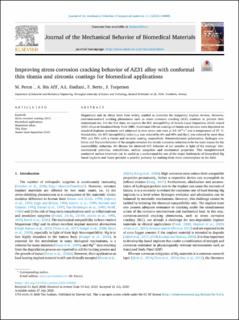| dc.contributor.author | Peron, Mirco | |
| dc.contributor.author | Bin Afif, Abdulla Shaikh Abdul Qader | |
| dc.contributor.author | Dadlani, Anup | |
| dc.contributor.author | Berto, Filippo | |
| dc.contributor.author | Torgersen, Jan | |
| dc.date.accessioned | 2021-04-22T08:52:43Z | |
| dc.date.available | 2021-04-22T08:52:43Z | |
| dc.date.created | 2020-08-16T13:09:30Z | |
| dc.date.issued | 2020 | |
| dc.identifier.citation | Journal of The Mechanical Behavior of Biomedical Materials. 2020, 111 . | en_US |
| dc.identifier.issn | 1751-6161 | |
| dc.identifier.uri | https://hdl.handle.net/11250/2739027 | |
| dc.description.abstract | Magnesium and its alloys have been widely studied as materials for temporary implant devices. However, corrosion-assisted cracking phenomena such as stress corrosion cracking (SCC) continue to prevent their mainstream use. For the first time, we explore the SCC susceptibility of Atomic Layer Deposition (ALD) coated AZ31 alloys in Simulated Body Fluid (SBF). Conformal 100 nm coatings of titania and zirconia were deposited on standard dogbone specimens and subjected to slow strain rate tests at 3.5 10-6 s-1 and a temperature of 37 °C. Remarkably, the SCC susceptibility index IUTS was reduced by 6% and 40% and the Iε was reduced by more than 70% and 76% with a titania and zirconia coating, respectively. Potentiodynamic polarization, hydrogen evolution and fracture behavior of the samples revealed the drastic corrosion reduction to be the main reason for the susceptibility reduction. We discuss the observed SCC behavior of our samples in light of the coatings’ electrochemical activities, wettabilities, surface integrities and mechanical properties. This straightforward conformal surface treatment can be useful as a workaround for one of the major bottlenecks of biomedical Mg based implants and hence provides a possible pathway for making them more commonplace in the field. | en_US |
| dc.language.iso | eng | en_US |
| dc.publisher | Elsevier | en_US |
| dc.rights | Navngivelse 4.0 Internasjonal | * |
| dc.rights.uri | http://creativecommons.org/licenses/by/4.0/deed.no | * |
| dc.title | Improving stress corrosion cracking behavior of AZ31 alloy with conformal thin titania and zirconia coatings for biomedical applications | en_US |
| dc.type | Peer reviewed | en_US |
| dc.type | Journal article | en_US |
| dc.description.version | publishedVersion | en_US |
| dc.source.pagenumber | 11 | en_US |
| dc.source.volume | 111 | en_US |
| dc.source.journal | Journal of The Mechanical Behavior of Biomedical Materials | en_US |
| dc.identifier.doi | 10.1016/j.jmbbm.2020.104005 | |
| dc.identifier.cristin | 1823486 | |
| dc.relation.project | Norges forskningsråd: 295864 | en_US |
| cristin.ispublished | true | |
| cristin.fulltext | original | |
| cristin.qualitycode | 1 | |

